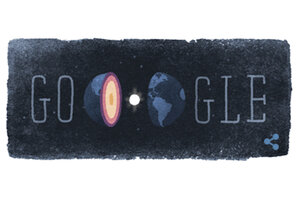How Inge Lehmann discovered the truth about the Earth's core
Inge Lehmann, who is honored Wednesday with a Google Doodle, made a name for herself at a time when there were few women scientists. Yet her rigorous observations of earthquake movements allowed her to glimpse the nature of the Earth's core.

Google celebrates Inge Lehmann with a spinning doodle.
Danish seismologis Inge Lehmann was born at a time when there were few women working in the scientific field. Yet her insight, coupled with her rigorous observations of the way earthquakes moved through the Earth’s core, changed the scientific understanding of what’s at the center of the Earth.
The Earth’s core is not a single ball of molten metal, Ms. Lehmann realized – instead, there’s a solid inner core surrounded by a roiling liquid outer core, as depicted in today's Google Doodle.
Born in Denmark in 1888, Lehmann was educated at an elementary school run by Hannah Adler, the aunt of the famous physicist Niels Bohr. The school treated boys and girls equally when it came to studies, which was unusual for the time. “No difference between the intellect of boys and girls was recognized,” Lehmann later wrote, “a fact that brought some disappointment later in life when I had to recognize that this was not the general attitude.”
In 1925, Lehmann became an assistant to Niels Erik Nørlund, a mathematician at the University of Copenhagen who studied the Earth’s interior. There, she helped Mr. Nørlund install observatories across Denmark and Greenland to measure earthquakes. Since the Earth’s core is too hot, pressurized, and distant to measure directly with probes, scientists have to look at seismic activity to learn what the core is made of and how it behaves.
Four years later, Lehmann studied the seismic readings from a large earthquake that shook New Zealand, and realized that the movement of the quake (measured by “P-Prime waves”) didn’t match what would be expected if the Earth had a single molten core, as scientists had assumed. Instead, the waves’ movement suggested that the Earth’s core was divided into two distinct parts: a solid inner core and a molten outer core. Because there were no computers to store seismic data, Lehmann wrote down her observations on cardboard cards and categorized them by placing them in different oatmeal boxes. With this system, Lehmann gained new insight into the composition of the inner Earth.
Lehmann’s theory of a solid inner core described earthquake movement more accurately than the existing model, and it was quickly accepted by leading seismologists. But as a woman working in the male-dominated scientific community, Lehmann had to put up with a good deal of sexism. She later told her nephew, Niles Groes, “You should know how many incompetent men I had to compete with – in vain.” Her relationships with colleagues deteriorated toward the end of her career in the 1950s, as her impatience with their “incompetence” got the better of her.
In spite of the prejudice she faced, Lehmann’s brilliance allowed her to peer beneath the Earth’s surface to see what was underneath. In 1971, she became the first woman to win the William Bowie Medal for contributions to geophysics, and in 1997, the American Geophysical Union created the Inge Lehmann Medal to honor scientists who study the Earth’s mantle and core.

